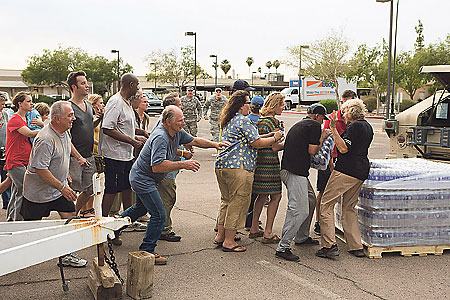
First, the lights go out. Then, gridlock, fires, looting and mass panic. Watch “The Blackout” unfold, from the perspective of those who keep filming
Imagine ten days of a catastrophic blackout. No mobile phone service, no ATM withdrawals, no working street lights, no available petrol. The alarming fact is that it could well happen.
Survival Scenario
On Nov 11, at 11pm, the lights will go out. “The Blackout”, National Geographic Channel’s two-hour, movie event, imagines the realistic story of a national power failure in the USA, caused by a cyber-attack — told in real time, over ten days, by those who keep filming on cameras and phones.
Gritty, visceral and totally immersive, see what it might take to survive from Day One, and who would be left standing when the lights come back on.
Startlingly Real Footage
“The Blackout” combines startling user-generated footage from recent real blackouts and disasters like Hurricane Sandy, intercut with the dramatic shot footage in feature film style.
Follow the struggles of ordinary people wrangling through the chaos and one “prepper” family [who believes a catastrophic disaster is likely to strike and takes active measures to prepare, including by stockpiling food and other supplies].
Cyber Reality
Today, cyber threats are very real and can indeed cause power surges that physically damage electrical equipment.
Said Leon Panetta, the former US Secretary of Defence, “The next Pearl Harbour we confront could very well be a cyber-attack that cripples our power systems, our grid, our security systems, our financial systems.”
What Would You Do?
“The Blackout” not only plays like a true thriller, making you think twice about how prepared you might be if this actually happens, but also should be a powerful tool to inspire discussion on what we can do to strengthen our defences from such an attack,” said Jonathan Rudd, Director at Raw Television, which produced the show.
About 70 per cent of key power grid components in the US are more than 25 years old, and the average age of power plants is over 30 years old.
A 2013 US congressional report on grid vulnerability revealed that more than a dozen utilities reported “daily”, “constant” or “frequent” attempted cyber-attacks, with one reporting approximately 10,000 attempts per month.
A Very Real Possibility
Don’t think you are vulnerable? Think again. Recent earthquakes, tsunamis, winter storms, hurricanes and other natural disasters have exposed weaknesses in infrastructures. Think stuck subways, grounded flights, domestic fires from candlelight, panicked buying at stores, downed ATMs and closed schools and businesses.
For ordinary people navigating the turmoil, questions arise: When does civility and morality change to hostility? How safe would your home be?
This hypothetical nightmare plays out on screen in real time. Day 1: Street lights are out, roadways are gridlocked, people are trapped on subways and elevators and most ATMs are unavailable.
Day 2: Toilets do not work and water does not run in some areas, there is no air conditioning, food rots in freezers, stores face massive demand for bottled water, canned foods, batteries and candles, and police, fire-fighters and medical personnel are inundated. There are also reports of looting and fires.
There are many more days yet.
“The Blackout”, part of National Geographic Channel’s Blackout Week, premieres on Nov 11, at 11pm, on StarHub TV Ch 411 & SingTel mio Ch 201.
ADVERTISEMENTS








